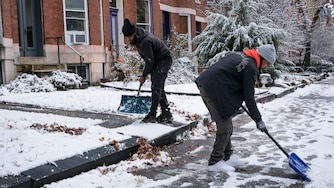Adam Dunn, who works at Titan Industrial Services near I-695, and his colleague Erik Rodman were heading to a chemical plant near the Francis Scott Key Bridge when they were stopped by the police.
The bridge was shut down after a ship ran into it, causing a catastrophic collapse.
As an army of government agencies responded to the calamity Tuesday morning, at least 35,000 daily commuters, including Rodman, and businesses and communities dependent on the bridge were trying to figure out how it would impact them personally.
The collapse of the bridge is going to impact everything, Dunn said — shipping, commuting — prices will likely increase.
“This will be a nightmare for years now,” Dunn said.

The bridge, which is one of three ways to cross Baltimore’s harbor, serves as a daily source of transportation for people who work or live in the surrounding area. Commuters are trying to comprehend what this means for future travel and the ripple effect of the collapse.
Rodman said the collapse will be an inconvenience to him, living in Dundalk and used to taking that route to work every day around 6 a.m. That is nothing compared to the experience of those who were on the bridge who may have lost their lives, he said.
”To see it fall down like that, it’s heartbreaking. And it fell down so easily,” said Rodman, who said the sound of the collapse woke him up.
Local businesses were already feeling the impact.
A manager at the Home Depot Distribution Center on Tradepoint Avenue in Sparrows Point just over the bridge said she was experiencing incoming and outgoing delivery problems, but told a Baltimore Banner reporter she didn’t have time to talk because she’s trying to manage it all.
Aaron Tomarchio, an executive vice president of corporate affairs with Tradepoint Atlantic, said the company halted vessel activity until search-and-recovery efforts conclude. He added that at least 20,000 people go in and out of the facility daily to work and do business at the privately owned logistics hub on Sparrows Point. They’re staying informed on traffic detours.
“Tradepoint Atlantic has been in constant contact with emergency response officials and leaders from Baltimore City, Baltimore County and the State of Maryland and will continue to coordinate during this extremely challenging situation. As a part of the Port of Baltimore, we are committed to helping our local and state partners and the entire port community recover and rebuild from this tragedy,” the company shared in a statement.
On the ground, people couldn’t help but reflect on how the bridge plays a role in their day-to day.
Justin McCarty, who lives in Glen Burnie with his girlfriend, drives the bridge daily when he delivers DoorDash orders. He usually delivers during the night, starting late evening and working well into the early hours, stopping at around 3 a.m.
He didn’t deliver the night of the collapse, even though he needed the money. His girlfriend, Trinity Summers, and his mother hid his keys to keep him from working because he was tired. It was around 11 p.m. Now he is grateful that they did. He will have to find another route, but he is alive.
”I don’t know how we are going to move forward from this,” he said. “It’s such an incredible loss.”
Dana Alston, who grew up in Turner Station nearby, stared out at the water mystified by what he saw. When Alston was 5 years old in the early 1970s, he said, he used to ride his bike out to watch the construction of the bridge.
”It’s just surreal,” he said. “I’ve driven that bridge hundreds of times, thousands of times in my life.”
Alston, who works in marketing, worried about the repercussions of the collapse, not just for the local economy but the entire region. He anticipated that, in addition to rebuilding the bridge, cleaning up debris to allow ships back in and out of the port could be an immense and time-consuming challenge.
”You have no ships coming in and out. You have everybody that works at the port,” he said. “The entire cruise industry that leaves from Baltimore could collapse, and then what this does to the supply chain.”

Others who live nearby were still taking it all in.
On Dundalk Avenue on Tuesday morning, onlookers gathered across the street across from the Logan Village Center shopping strip, standing off the shoulder of the road where the collapsed span of bridge was clearly visible.
John Paulino, who was carrying his 8-week-old puppy Chyna, said he woke up around 1:30 or 2 a.m. from the sound of the bridge collapsing. Paulino, who lives near the shopping strip, said he checked his front doorbell camera thinking the noise came from directly outside his house.
He found out minutes later that the bridge had collapsed.
”It was crazy,” he said.
This story will be updated.




Comments
Welcome to The Banner's subscriber-only commenting community. Please review our community guidelines.